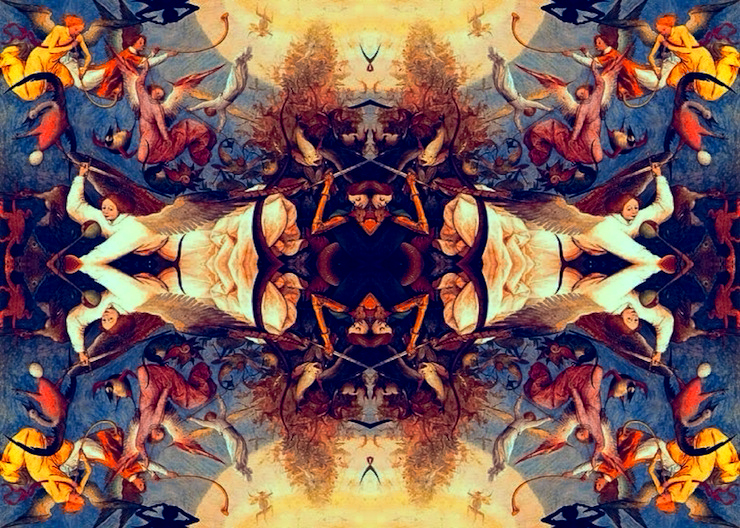For three years I have been creatively launching visual experiments at a rapid pace. Although my sense of what this is about is theorized to a lesser degree than it would be if I was working a great or robust theory, nevertheless, I do comprehend what is a creative impulse when this impulse is about the artistic intention being overwhelmed by generative routine and stochastic disruptions.
Especially this summer my experiments have been gripped by the procedures for mirroring photographs and the work of Peter Brueghel and Tibetan Tangkas. (See public artworks: symmetry-hypotheses@tumblr)
The question I pose to myself about this weird form of channeling of the fragile random into a moment in which I finally decide to capture and etch a selection is: why has this been compelling me?
My creative preoccupations are in some relation with my investigations into serendipity in adult development, and I have been exploring day in and day out, as against becoming sunk again into the thin, question-less titanisms of the workaday world. Ken and I have been working on a folk neuroscientific, phenomenographic form for self-evaluation that captures its data in the mandala of a four quradrant matrix, (or Johari Window.) My production of symmetry oriented kitsch is related to that too.
- Contemporary Western consciousness may not be able to experience the mythic world as the ancients did, but simply to engage with it may be the beginning of that remembering which the undying deities demand. The intellect may be drawn not to ego’s greedy colonizing—”gods and goddesses in everyone” as both description of and justification for known states—but to a meeting with the symbolic. Those old tales, with their impossible metamorphoses, their incomprehensible plotlines, their evocations of terror and of bliss, can act as a series of Rorschach tests. Which is the moment in the tale, which is the image, that seizes me? Who is the character with whom I identify, whom would I hiss off the stage? At which moment do I burst out “But it’s not fair!”’ and have to remem- ber once more that in these just-so stories, that’s simply the way it is? Thus I learn again about myself, and in doing so may also learn about others, as I am recalled to that dream image, this fantasy, that unexpected affect, which has entered the consulting room from an ancient place.As Jung (1968) emphasized, this is far from being a parlor game: “When archetypal contents assume grotesque and horrible forms and lead to fears of madness, it is absolutely necessary to supply these fantastic images that rise up so strange and threatening before the mind’s eye with some kind of context, so as to make them more intelligible. Experience has shown that the best way to do this is by means of comparative mythological material” (para. 38). And as well as “calm- ing and clarifying a consciousness that is all at sea” (ibid.), attention to the myth- ical may help both therapists and those with whom they work to reach a deeper understanding of what it is to be human. Donald Kalsched (1995) expresses this eloquently in writing of his own approach to psychotherapy:
We must remember that mythology is where the psyche “was” before psychology made it an object of scientific investigation. By drawing attention to the parallels between the findings of clinical psycho- analysis and ancient religious ideation we demonstrate how the psychological struggle of contemporary patients (and those of us trying to help them) runs rather deeper into the symbolic phe- nomenology of the human soul than recent psychoanalytic dis- cussions of trauma or the “dissociative disorders” are inclined to acknowledge. Not everyone is helped by an understanding of these parallels, but some people are, and for them, this “binocu- lar” way of viewing, simultaneously, the psychological and reli- gious phenomena is equivalent to finding a deeper meaning to their suffering, and this in itself can be healing. (p. 6, his italics)
On the Making of Myths:Mythology in Training
Ann Shearer -Journal of Jungian Theory and Practice V6 NO. 2 2004

